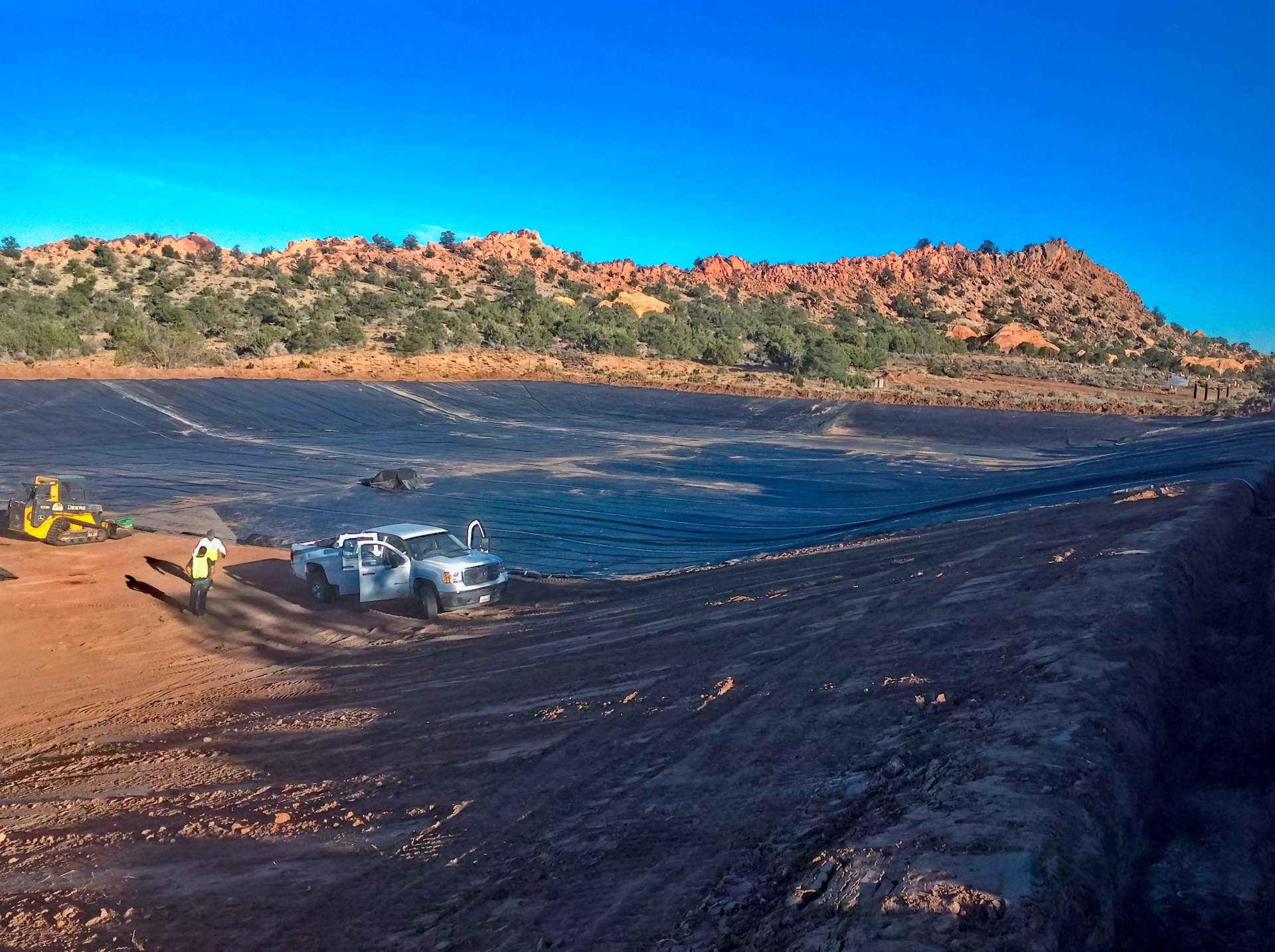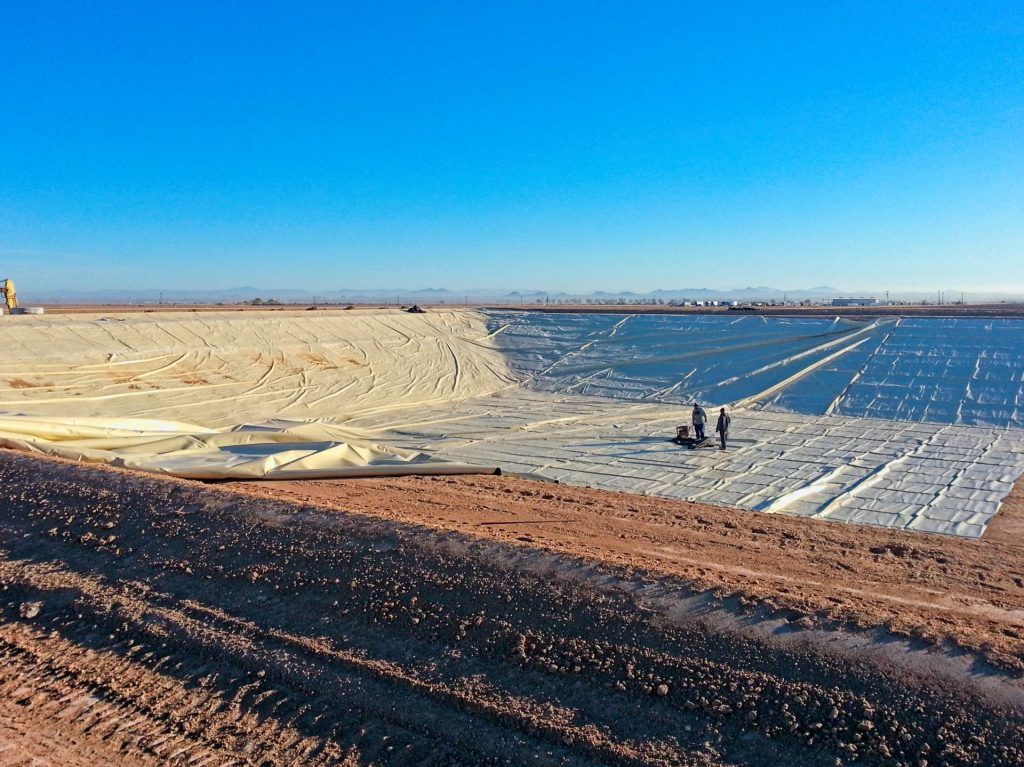Large Pond Liner Materials
Choosing the best pond liner material can often be confusing for many customers with so many options available today.


Fortunately, due to Western Environmental Liner’s extensive 30 year history with various pond liner materials, we are able to select the best pond liner material for each particular application which enables us to provide the best value to our customers.
Western Environmental Liner prides itself on never selling a pond liner product that is overkill for an application or selecting a pond material that won’t get the job done right. Be assured that we have your best interest at heart.
Due to its affordability, in most cases we recommend a reinforced pond liner product for most pond liner applications. These type of pond liners are often lighter, stronger, much more tear resistant, & less expensive than unreinforced pond liners. One thing to note is that thickness does not always equate to quality. An unreinforced pond liner product often needs to be much thicker than a reinforced pond liner to work well. When this extra thickness is factored into the price, an unreinforced pond liner is often more expensive overall. Not every situation is the same though, for instance, when a large pond liner needs to conform perfectly to every nook and cranny of a pond, a highly flexible and malleable film such as pvc may be the best option. Large preformed pond liners often produce the best results.
For water ponds, the biggest consideration should be if the pond liner will be exposed to the sun or not. Sun exposure to a pond liner is often a necessary evil. Often with large ponds a steep slope is being used which can make covering the pond liner with dirt difficult due to the dirt falling down into the pond and leaving the liner exposed to the sun.
Reinforced Polyethylene (RPE) is often the best value liner material for most applications. It is very strong both in tear resistance and puncture resistance and is often stronger than products three times as thick and heavy. RPE comes in a variety of thicknesses from 12 mil up to 60 mils thick. RPE also has ranges of u.v resistance usually correlating with its thickness with some of the thicker RPE’s lasting well over 20 years in the sun. Please contact Western Environmental Liner for more details on what RPE liner that is right for you.
Reinforced Polypropylene is usually the best pond liner choice for exposed applications. Our 45 mil Reinforced Polypropylene will last over 20 years when exposed for water applications and also works well with many other fluids. Although more expensive than Reinforced Polyethylene, there is no need to worry about the sun’s rays destroying the liner for a very long time.
Although we do have our preferences which most often has to do with best value for the customer, we know sometimes other products are specified into a project and we can usually provide those materials as well. We provide liners that are also resistant to oils, chemicals, and waste, but these liner options are not normally described as a pond liner.
Due to the fact that Western Environmental Liner is one of the leading manufacturers of pond liners in the world, this enables us to offer large discounts and in many cases, warranty guarantees backed by our 30-year experience in the pond liner industry. Our dedicated staff of pond liner professionals are ready to answer your questions to help ensure you choose the right pond liner for your application. Pond liners can offer an unlimited potential for design, long lasting capacity, and low maintenance cost. An investment in a high quality pond liner will enable you to have a long lasting containment solution.

1. Do I need underlayment for a pond liner?
Yes. A geotextile underlayment is ideal to protect your liner from tearing or puncturing under the considerable weight of water in the filled pond. While the liner material is selected for its impermeability, the underlayment is chosen for its ability to withstand puncturing from any rock or roots that may not be obvious prior to lining the pond. See our guide to Geotextile Underlayment.
2. How much should a pond liner overlap?
For large ponds as a general rule you need an extra 5 feet of liner at all edges to bury in the securing trench that holds the liner edge - larger will require more overlap, smaller less. Estimate the liner size using our online pond liner calculator and make sure that the edges of the material are fully covered so no wind or weather elements can work under the liner. Plan to unroll and See our Large Pond Liner Installation Guide for all of the factors to consider.
3. Can you join a pond liner?
Installing a pond liner from multiple pieces is a very skilled task. Welding in the field is one of the principal causes of failure - much depends on the installation crew. The best weld happens in the factory using precision equipment in a controlled environment, to create the custom liner you need. See our guide to Installation Tips and Pitfalls with Pond Liners for these and other considerations.
4. What is the best liner for a pond?
Reinforced Polypropylene (RPP) is best for smaller fish ponds, while Reinforced Polyethylene (RPE) is best for larger fish ponds. And not just for fish but for any kind of water-retaining pond, in general RPE is often better than HDPE for pond liners. Many retail providers offer EDPM which is a synthetic rubber, but this material can usually be outperformed by PVC, RPE and HDPE materials as pond liners.
5. How long does a pond liner last?
Every pond liner should give good service for 20 years. Look for a materials provider and an installer who will offer a 20-year warranty. This is the hallmark of quality, and your only recourse if the liner fails before its time.
Please contact us via either e-mail or phone to help you choose the best value pond liner for your application.
(RPE) is often the best value liner material for most applications. It is very strong both in tear resistance and puncture resistance and is often stronger than products three times as thick and heavy. RPE comes in a variety of thicknesses from 12 mil up to 60 mils thick. RPE also has ranges of U.V. resistance usually correlating with its thickness with some of the thicker RPE’s lasting well over 20 years in the sun. Please contact Western Environmental Liner for more details on what RPE liner that is right for you.

